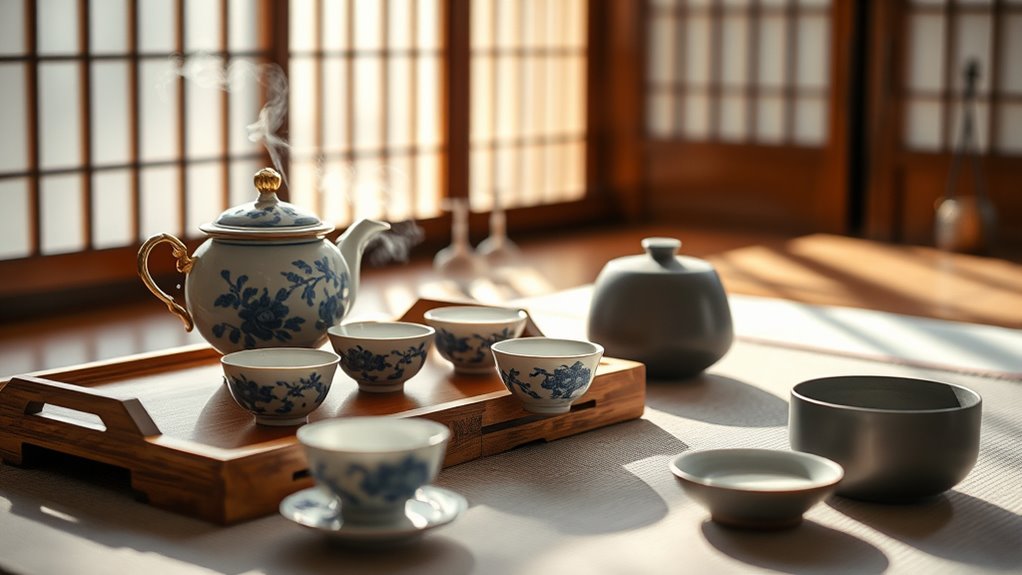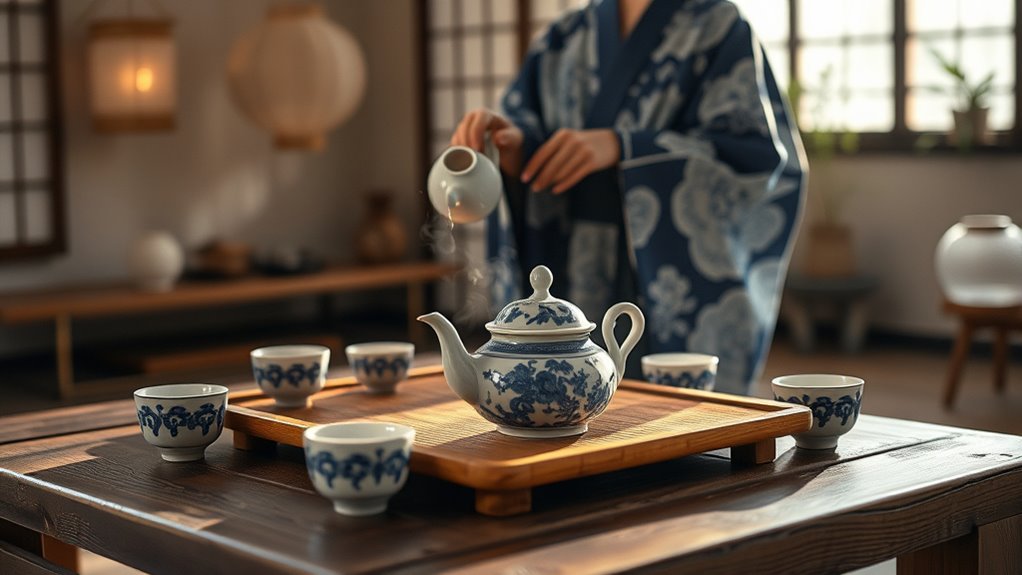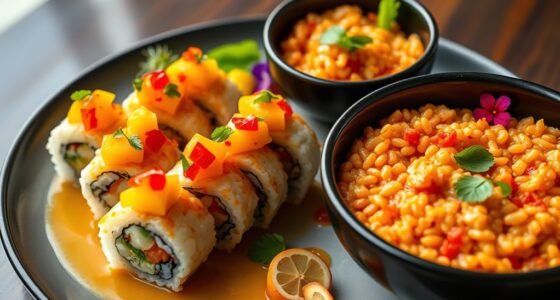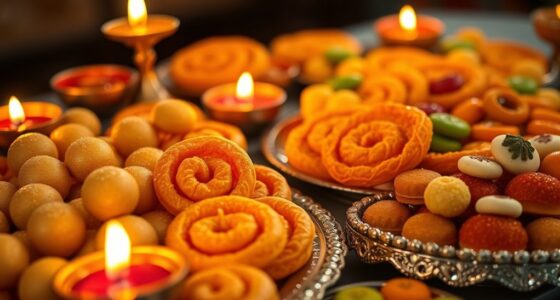Tea ceremonies are more than just brewing tea; they are cultural rituals that embody tradition, respect, and mindfulness. They transform a simple drink into an artful experience that promotes harmony among participants. Using carefully chosen utensils and following specific etiquette reflects deep cultural values. Today, many enjoy blending these traditions with modern life, emphasizing intentionality and connection. If you keep exploring, you’ll discover just how rich and meaningful these timeless practices truly are.
Key Takeaways
- Tea ceremonies are revered as artistic rituals that embody cultural values, fostering mindfulness and harmony among participants.
- Proper etiquette and reverent handling of utensils reflect respect for tradition and enhance the ceremonial experience.
- Ceremonial utensils like tea bowls and whisks have symbolic significance, representing aesthetic and cultural principles.
- Modern adaptations blend traditional practices with casual settings, emphasizing mindfulness, intent, and cultural appreciation.
- These ceremonies transform tea drinking into meaningful moments of reflection, connection, and cultural preservation.

Have you ever wondered what makes a tea ceremony so special? It’s more than just brewing a cup of tea; it’s an art form that embodies centuries of tradition, respect, and mindfulness. Central to this experience are the nuances of tea etiquette, which guide how you approach and participate in the ritual. Knowing the proper way to handle ceremonial utensils isn’t just about manners—it’s about honoring the history and philosophy behind the ceremony. These utensils, such as the tea scoop, whisk, and bowl, aren’t randomly chosen; each has a purpose and symbolism that enhances the overall experience. When you follow the correct tea etiquette, you show respect for the host, the guests, and the tradition itself. This attentiveness helps foster a sense of harmony and mindfulness that transforms a simple act of drinking tea into a meaningful ritual.
The ceremonial utensils are often crafted with care, reflecting the aesthetic and cultural values of the tradition. For example, in a Japanese tea ceremony, the chawan (tea bowl) is carefully selected for its shape and texture, which influence the flavor and presentation. The bamboo whisk, or chasen, is designed to aerate the matcha powder, creating a frothy, inviting cup. Handling these utensils with reverence isn’t merely about protocol; it’s about connecting with centuries of cultural wisdom. When you grasp the tea scoop or rotate the tea bowl, you participate in a dialogue between the present moment and the historical practices that have been passed down through generations. Using ceremonial utensils correctly demonstrates your appreciation and understanding of the ceremony’s depth, elevating the experience beyond mere consumption.
In modern times, many people adapt traditional tea etiquette to fit contemporary settings, blending old customs with new interpretations. Some host casual tea gatherings that incorporate the spirit of the ritual without strict adherence to every detail, emphasizing mindfulness and connection over formality. However, even in informal settings, respecting the ceremonial utensils and understanding their significance can deepen your appreciation for the process. It’s about being intentional—taking the time to prepare, handle, and enjoy the tea with mindfulness. This approach transforms a simple act into a moment of pause, reflection, and cultural appreciation. Whether you’re participating in a traditional ceremony or a modern adaptation, understanding and respecting tea etiquette and ceremonial utensils allows you to experience tea not just as a beverage, but as a meaningful cultural practice that fosters serenity and respect.
Frequently Asked Questions
How Do Tea Ceremonies Vary Across Different Regions Worldwide?
You’ll notice that tea ceremonies vary widely across regions, reflecting local customs and cultural adaptations. In Japan, you focus on precision and mindfulness, while in China, the emphasis is on harmony and tradition. In Morocco, you enjoy a lively, social ritual with mint tea, and in Britain, afternoon tea is a refined, leisurely affair. These differences highlight how regional customs shape each ceremony, making them unique expressions of local culture.
What Are the Health Benefits Associated With Traditional Tea Ceremonies?
You might think tea ceremonies are just about tradition, but they also offer real health benefits. The antioxidant properties in tea help protect your cells, reducing the risk of illness. Plus, the mindful ritual can considerably lower stress levels, promoting relaxation. By embracing these ceremonies, you enhance your well-being, connecting with centuries-old practices that nourish both your body and mind, making every sip a healing experience.
How Have Modern Lifestyles Influenced Traditional Tea Ceremony Practices?
Modern lifestyles have profoundly influenced traditional tea ceremonies by blending them with contemporary adaptations. You might find tea rituals simplified for busy schedules or infused with new elements like modern aesthetics or technology. Instead of strict adherence, you adapt practices to fit your daily routine, making the experience more accessible and relevant. This evolution helps preserve the essence of tea ceremonies while allowing you to enjoy their calming and cultural benefits in today’s fast-paced world.
Are There Specific Etiquette Rules for Participating in Tea Ceremonies?
You should follow specific etiquette rules when participating in tea ceremonies to show respect and appreciation. Nearly 80% of participants find adhering to tea etiquette and participation protocols enhances the experience. Focus on handling utensils carefully, bowing politely, and listening attentively. These practices honor tradition and create a harmonious atmosphere. Remember, observing proper tea etiquette demonstrates your respect for the ceremony’s cultural significance and enriches your overall experience.
What Role Do Tea Ceremonies Play in Fostering Social Connections Today?
Tea ceremonies play a crucial role in fostering social connections today by serving as meaningful social bonding rituals. When you participate, adhering to tea ceremony etiquette shows respect and helps create a relaxed, respectful atmosphere. Engaging in these rituals allows you to connect deeply with others, share traditions, and enjoy a moment of calm. This shared experience strengthens relationships and promotes understanding, making tea ceremonies a valuable way to build community and connection.
Conclusion
As you sip from the delicate cup, you become part of a timeless dance where tradition and modernity intertwine like threads in a vibrant tapestry. Tea ceremonies whisper stories of centuries past while embracing new interpretations, inviting you to find harmony amid change. In this gentle ritual, you discover that each pour is a bridge—connecting history, culture, and your own mindful presence—transforming a simple act into a sacred symphony of connection and reflection.








